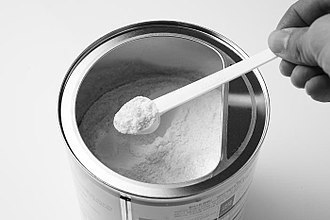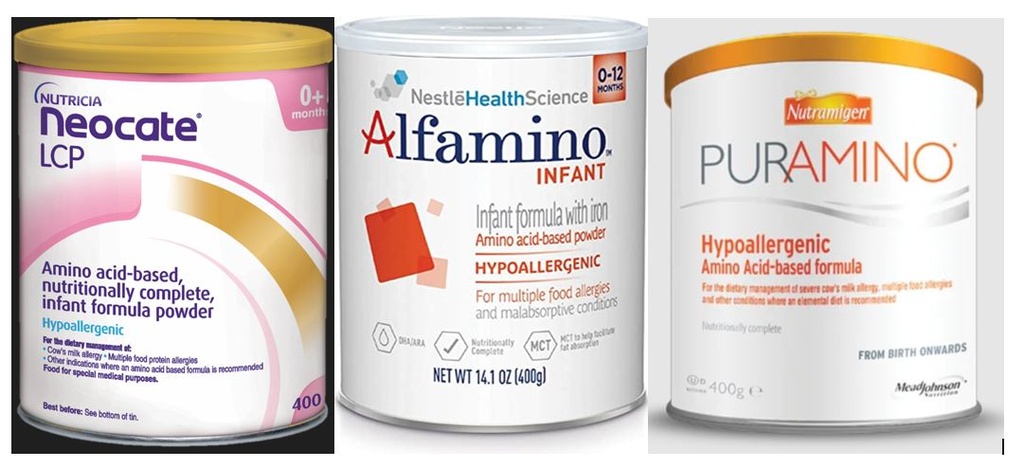INFANT FORMULA, HYPOALLERGENIC, 1st age, powder, 400g
Valid Article
INFANT FORMULA hypoallergenic
Infant Formula (infant milk)
Definition
Infant formula designed for infants with persistent, explosive diarrhoea after each meal, and who do not tolerate standard infant formula.
See the Statement on infant feeding.
Specifications
Technical specifications
Nutritional properties
Compared to standard infant formula, hypoallergenic infant formula must contain a protein source composed of highly hydrolysed amino acids, with more than 95% of them being free amino acids. Lactose-free is no longer a requirement for this product.
Examples:
- 95-100% free amino acids: Nutramingen 1 LGG
- 100% free amino acids: Neocate LCP, Nutramigen Puramino, Elecare
Nutritional values | Unit | Per 100 ml | |
| Min. | Max. | ||
| Energy | kcal | 66 | 68 |
| Proteins equivalent | g | 1.8 | - |
| Lipids | g | 3.3 | 3.7 |
| Carbohydrates | g | 6.9 | 7.3 |
| Minerals | |||
| Calcium | mg | 70 | 77 |
| Phosphorus | mg | 44 | 50.2 |
| Potassium | mg | 72.9 | 76 |
| Magnesium | mg | 6 | 8.1 |
| Sodium | mg | 22 | 29.3 |
| Iron | mg | 0.66 | 1.01 |
| Zinc | mg | 0.61 | 0.73 |
| Copper | µg | 50 | 57 |
| Iodine | µg | 13.5 | 15 |
| Manganese | µg | 7 | 11 |
| Chloride | mg | 53 | 60 |
| Selenium | µg | 2.4 | 3.4 |
| Vitamins | |||
| Retinol (Vit A) | µg | 57 | 66 |
| Cholecalciferol (Vit D) | µg | 1.63 | 1.7 |
| Tocopherol (Vit E) | mg | 0.61 | 1.5 |
| Ascorbic ac. (Vit C) | mg | 6.4 | 11 |
| Thiamin (Vit B1) | µg | 40 | 80 |
| Riboflavin (Vit B2) | µg | 54 | 130 |
| Niacin (Vit B3) | µg | 550 | 930 |
| Pyridoxine (Vit B6) | µg | 50 | 60 |
| Cobalamin (Vit B12) | µg | 0.12 | 0.19 |
| Phylloquinone (Vit K1) | µg | - | 6.1 |
| Folate (Vit B9) | µg | 11.4 | 17 |
| Biotin (Vit B7) | µg | 1.62 | 2.59 |
| Pantothenic acid (Vit B5) | µg | 380 | 440 |
Physical and organoleptic properties
- Texture: free from lumping
- Appearance: white of slightly yellowish fine powder, free from impurities/coloured particles. The reconstituted milk shall be a homogenous white liquid.
- Smell: neutral and typical of milk. It shall not be pungent.
- Taste: characteristic of milk; not rancid, pungent or unpleasant taste.
Packaging & Labelling
The primary and secondary packaging must protect the hygienic and nutritional qualities of the product during transport, handling, and storage under MSF field conditions.
Primary packaging (unit packaging): 400 g aluminium tin, sealed with aluminium foil and a plastic lid, including a measuring spoon. The lid is designed to protect the milk from humidity after the aluminum foil is removed.
For more information on packaging labelling, refer to the CHECKLIST CONTROL UPON RECEIPT specialised food.
Instructions for use
This product must be prepared with safe drinking water.
Preparation
Preparation and Reconstitution of infant formula (Good Hygiene Practices)
- Preparation should take place in a clean environment on cleaned and disinfected work surfaces.
- Wash hands thoroughly with soap and warm water, then dry with a clean cloth or single-use towel.
- Boil water for 2 minutes, then allow to cool to 60-70°C before adding the powder. Use a digital food-grade thermometer to check the water temperature.
- Pour the exact required amount of water (at 70°C) (follow the instructions on the packaging) into a cleaned and sterilised container. Use a 100 ml graduated measuring jug or a 100 ml graduated glass beaker with a spout.
- Add the required amount of infant formula powder (follow the instructions on the packaging). Using more or less powder than indicated may make the infant sick.
- Mix the preparation with a sterilised utensil until completely diluted.
- Label the container: "Infant formula, day and time of preparation".
- Cool the preparation to feeding temperature (approx 37°C).
- Use within 2 hours.
- Remark on the measuring spoon:
- Use the measuring spoon provided in the tin. Do NOT use a measuring spoon from another product or manufacturer.
- Do not wash the measuring spoon; return it to the tin after use.
- Ensure the measuring spoon remains dry; if it become wet, dry it thoroughly before placing it back in the tin.
- The measuring spoon supplied generally corresponds to the dose of powder required for 30 ml of water.
Administration
- Infant formula should be administered at either room or body temperature. Use a thermometer (preferably digital) to check the temperature.
- It is best to prepare and serve infant formula immediately after cooling to body temperature. Reducing the time between preparation and consumption reduces the risk to the infant.
Conservation of reconstituted infant formula
- If not consumed immediately, refrigerate the preparation at 4°C (do not exceed 4ºC) in a clean bottle or other container with a lid, immediately after cooling to body temperature.
- Refrigerated preparation should be consumed within 24 hours.
- Do not prepare infant formula in advance if it cannot be consumed within 2 hours or if refrigeration is not available.
- Never store infant formula in a refrigerator for more than 2 hours after preparation
- Discard any preparation that has not been consumed within 2 hours.
- Discard any refrigerated preparation that has not been consumed within 24 hours.
Storage
- Below 25ºC - Protect from sunlight ‐ Protect from humidity
- Shelf-life: usually 24 months from the manufacturing date stated on the packaging.
- Infant milk formula should be stored in its original packaging to prevent any contamination.
- After opening, consume the infant milk formula within 3 weeks.
- Destroy the powdered milk immediately if the are any changes in colour, smell, or appearance, even if the expiry date has not been reached, as this indicates a high risk of bacteriological contamination.
Follow the procedure QA-NFOS-SOP3 Storage of specialised food (NFOS).
For procedures related to Quality Control, refer to Preliminary remarks on specialised food.





![[NSFSCRECOSE] CHECKLIST CONTROL UPON RECEIPT specialised food, English](/web/image/product.template/572035/image_256/%5BNSFSCRECOSE%5D%20CHECKLIST%20CONTROL%20UPON%20RECEIPT%20specialised%20food%2C%20English?unique=c6f8e93)
![[NSFSCRECOSF] CHECKLIST CONTROL UPON RECEIPT specialised food, French](/web/image/product.template/572046/image_256/%5BNSFSCRECOSF%5D%20CHECKLIST%20CONTROL%20UPON%20RECEIPT%20specialised%20food%2C%20French?unique=c6f8e93)
![[PCOOTHEF1C-] FOOD GRADE THERMOMETER, digital, with cord](/web/image/product.template/560125/image_256/%5BPCOOTHEF1C-%5D%20FOOD%20GRADE%20THERMOMETER%2C%20digital%2C%20with%20cord?unique=a16b7f8)